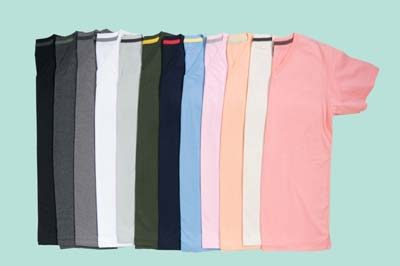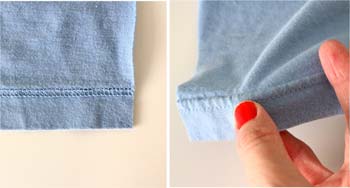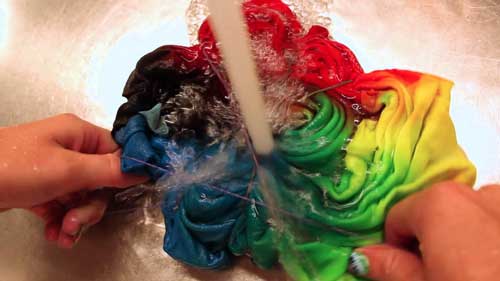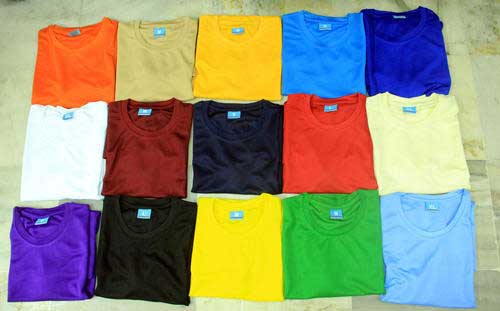
T-shirts are the most comfortable piece of clothing in anyone’s wardrobe. They can be worn casually or teamed up with a blazer for a semi-formal look. They can come with or without collars and various sleeve lengths. Sometimes there are graphics printed on the front or back for a cool look.
Not all t-shirts are created equally. Different blends of different threads result in different types of t-shirt fabrics. The quality of these fabrics vary depending on these blends, the process of manufacturing and dyeing, and the thread count.
Some t-shirts are stiff and scratch our skin when we first wear them. That’s because they have a polish that makes them look good and retains a nice fall. But they can be uncomfortable and you should know how to soften t-shirts so that you can enjoy wearing them.
In this article, you will learn why your t-shirt is stiff and why and how you can soften them. So, take a few minutes and read through your way to a more comfortable wardrobe.
Reasons Why Your T-Shirt Is Stiff And Stretchy?

Much goes into the process of manufacturing t-shirts. A few factors may result in new t-shirts feeling stiff and stretchy. The following is a detail discussion of these factors.
Improper Weave
For the weave of the t-shirt, cotton needs to be processed. This processing involves three steps of carding, combing, and blending. The first step is standardized and involves spinning the fabric and knitting it on a loom.
The second step – combing – is a costly process that requires a lot of labor. Therefore, this step is missed by many t-shirt manufacturers. And this is where the difference arises between a good quality t-shirt and an inferior one. Without enough combing, the cotton fibers don’t get softened.
Dyeing
The t-shirt quality is affected by the quality of dyes and colors used on the fabric. Natural dyes are preferred over ones that contain a lot of chemicals. These chemicals make the t-shirt fabric scratchy and irritating to the skin.
A strong dye will penetrate to the cotton fibers of the thread, causing it to become stiff. After a few washes, you’ll notice that the fabric becomes softer. However, bear in mind that if the color of your t-shirt is not fast, it might ruin other clothes that go with it in the washing machine.
Quality Of The Blend
100% cotton t-shirts are not always the only option. Cotton fibers are blended with other materials like jersey, polyester, or rayon. If these blends are not of superior quality, the t-shirt will not be comfortable to wear.
If you go back a few steps in the manufacturing process, you will see that the way the cotton plants were treated also has an impact on the yield. Plants treated with chemicals and fertilizers will produce cotton that is not of the top quality.
With organic cotton, you can be sure to get a t-shirt that is both high-quality and soft.
Thread Count
Thread count is the number of horizontal and vertical threads in a square inch. This number affects the softness of the t-shirt fabric. 500 is the magic thread count. A higher count of thread doesn’t necessarily mean the quality of the fabric is higher.
Thinner threads of t-shirt fabric are used by manufacturers to increase the thread count. Since the threads are thinner, although the thread count is higher, it’s not the most superior quality that makes the t-shirt soft.
How to Make T-Shirts Soft: Definitive Guide
Most problems have solutions and so do the trouble of scratchy t-shirts. Read on to know details about how to soften your t-shirt without damaging the design, color, or fit.
Vinegar Rinse

The vinegar wash is the ideal way to soften your t-shirt fabric that’s 100% organic cotton or has a cotton blend. This should not be too difficult as vinegar is a regular pantry item.
Take clear vinegar, baking soda, and some measuring cups and spoons. In a large bowl put one tablespoon of baking soda. Now slowly add a cup of vinegar. The slow pouring action will ensure that most of the effervescence stays in the bowl.
After the solution stops effervescing, use a spoon to stir and check if all the baking soda has dissolved. There should be no lumps.
Add this solution to the washing machine and put your t-shirt through a normal wash. Don’t forget to check the right settings for color and temperature. Dry the t-shirt and see the difference!
Salt Solution
Take a large pot and pour water in it. Add a cup of salt and stir till all the salt has dissolved. Turn up the heat and let the solution reach the boiling point. Now, in the sink, wet your t-shirt. Then put this gently into the salt solution. You could use a wooden spoon to prevent your hands from scalding.
Turn the flame to low and let the t-shirt be in the salt solution for 30-45 minutes. Keep the lid on. After the time is over, drain the t-shirt in a colander carefully.
Let the t-shirt cool and then rinse to get rid of extra salt. Now wash it normally in the machine. This process is okay for blends of polyester and cotton. It’s not suitable for rayon blends.
Pumice Stone
This is a very simple method of softening your t-shirt. Just rub with a pumice stone all over the garment. Make a solution of water and some fabric softener. Soak your shirt in this solution overnight. Wash it normally the next day and you’ll get a super-soft t-shirt!
Scouring Pads Or Sandpaper
If your t-shirts have graphics and letterings on them, they need a different way of softening.
Get some salt and powder detergent. Keep sandpaper or strong scouring pads handy.
Tackle the hemline, sleeves, and neckline with the sandpaper or pads. Don’t scrub the printed part of the t-shirt. Add a quarter cup of washing soda with one cup of salt.
Turn on the high heat setting on the washing machine and allow the water to fill. When the tub is nearly filled with water, add the soap and salt mixture. Allow the machine to go through one wash. Now, dry the fabric on high heat. Repeat a few times to get palpably softer t-shirt fabric.
Tumble Dry
While air-drying your t-shirt is more eco-friendly and saves energy, tumble drying can make the fabric more comfortable.
Add a fabric softener and wash normally in the washing machine. Hang your t-shirt out to dry up to 70%. Set your tumble dry mode to low and add some balls to work on the fabric.
You will get your t-shirt without all soft with none of the stretching.
For those who are allergic to soap, this trick will help you soften your new t-shirt. Set your washing machine to warm wash/cold rinse and add a cup of non-fat dry or evaporated milk. After you tumble dry on the delicate setting, you will be surprised how soft your t-shirt feels!
Why You Should Soften T-Shirt

There are a number of reasons why you should soften your t-shirt. Here goes the list:
- Softening makes the t-shirt more comfortable to wear.
- You want to get rid of the polish used on the fabric to stiffen it.
- It can protect your skin from the harmful effects of chemicals used to treat the cotton fiber.
- It makes the t-shirt fabric more breathable as softening creates pores on it.
- With a softened t-shirt that allows more airflow, you remain free from sweat.
Read our related article on T-Shirt Printing Business Equipment. Discover everything you need to have and know to get started!
Frequently Asked Questions (FAQ)
1. Is It Important To Soften T-shirts?
Answer: Yes, softening your new t-shirt will make it more comfortable to wear. Besides, the process will remove harmful chemicals used to treat fibers. These chemicals could be harmful for your skin. Besides, softening can create pores in the fabric, allowing airflow. This keeps you away from sweating.
2. What’s The Easiest Way To Soften A T-shirt?
Answer: The easiest way to soften your t-shirt is by rubbing with a pumice stone all over the fabric. Then soak the shirt in a solution of water and fabric softener overnight. Wash normally the next morning.
3. Why Is My T-Shirt Scratchy?
Answer: There could be a few reasons your t-shirt is scratchy. Maybe the weave is not right because the fiber strands were not combed enough. Or, the blend of polyester, rayon, or cotton may not have been of high quality.
Another reason could be the quality of dye and colors. Sometimes, the thread count of the t-shirt fabric is not right, resulting in a scratchy feel.
4. What Is Organic Cotton?
Answer: Organic cotton is cotton where the cotton plants were not treated with chemicals and fertilizers. Therefore, this type of cotton is completely natural and is softer than cotton that has been treated.
Read our related article on How to Remove HTV From Shirts. Don’t let mistakes put you down! These DIY methods can reverse any heat transfer vinyl problems.
Conclusion
You don’t need to go to great lengths to make your new t-shirts more wearable. Before you get into any kind of softening method, find out if your t-shirt is made from 100% cotton or has a blend of rayon, polyester, or jersey in it.
Since all softening methods don’t have the desired effect on all types of blends, it’s important to know the components of your t-shirt fabric.
Most of the solutions to stiff t-shirt problems are easy enough to be carried out at home with basic ingredients and the washing machine.
If you know how to soften t-shirts, you will get more comfortable wear. Following some basic pointers can save you from irritated skin and allergies. Next time you’re in the mood to buy a t-shirt, remember the important part about blends and the methods to treat them.
Here’s to a happier t-shirt experience!
Other Accessories That You May Like: